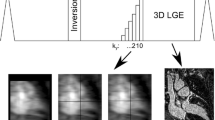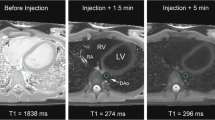Abstract
The purpose of the study was to estimate T 1 values of blood and myocardium after a single injection of Vasovist™ and to assess Vasovist™ for magnetic resonance coronary angiography (MRCA). For all exams 0.05 mmol/kg of Vasovist™ was injected. T 1 values of blood and myocardium were estimated over 30 min after injection. Twelve volunteers were examined on a 1.5-T Siemens system using a SSFP sequence with incrementally increasing inversion times for T 1-estimation and a breath-hold 3D IR-FLASH sequence for MRCA. Eleven examinations were performed on 1.5-T Philips system using the Look-Locker approach for T 1 estimation and a whole-heart inversion-prepared, 3D SSFP sequence for MRCA. SNR, CNR and image quality were assessed. T 1 values of blood (5 min: 230 ms vs. 30 min: 275 ms) and myocardium (5 min: 99 ms vs. 30 min: 130 ms) increased over time. Whereas the blood SNR (1 min: 23.6 vs. 30 min: 21.2) showed no significant differences, the blood-to-myocardium CNR (1 min: 18.1 vs. 30 min: 13.8) and the image quality (1 min: 2.9 vs. 30 min: 3.8) degraded over time. Due to long plasma half-time the T1-shortening effect of Vasovist™ remains effective over 30 min, which allows for multiple breath-hold or high-resolution MRCA.







Similar content being viewed by others
References
Dissmann W, de Ridder M (2002) The soft science of German cardiology. Lancet 359:2027–2029
Karnegis JN, Heinz J (1979) The risk of diagnostic cardiovascular catheterization. Am Heart J 97:291–297
Nieman K, Cademartiri F, Lemos PA, Raaijmakers R, Pattynama PM, de Feyter PJ (2002) Reliable noninvasive coronary angiography with fast submillimeter multislice spiral computed tomography. Circulation 106:2051–2054
Leber AW, Knez A, Becker C et al (2003) Non-invasive intravenous coronary angiography using electron beam tomography and multislice computed tomography. Heart 89:633–639
Barkhausen J, Hunold P, Jochims M et al (2002) Comparison of gradient-echo and steady state free precession sequences for 3D-navigator MR angiography of coronary arteries. Rofo 174:725–730
Barkhausen J, Hunold P, Waltering KU (2004) MRI in coronary artery disease. Eur Radiol 14:2155–2162
Hackenbroch M, Nehrke K, Gieseke J et al (2005) 3D motion adapted gating (3D MAG): a new navigator technique for accelerated acquisition of free breathing navigator gated 3D coronary MR-angiography. Eur Radiol 15:1598–1606
Thomas D, Krug B, Hackmann D et al (2004) MR-coronary angiography: comparison of SSFP and spoiled GRE sequence (bright blood technique) and a TSE sequence (black blood technique) in healthy volunteers. Rofo 176:1589–1598
Giorgi B, Dymarkowski S, Maes F, Kouwenhoven M, Bogaert J (2002) Improved visualization of coronary arteries using a new three-dimensional submillimeter MR coronary angiography sequence with balanced gradients. AJR Am J Roentgenol 179:901–910
Spuentrup E, Botnar RM (2006) Coronary magnetic resonance imaging: visualization of the vessel lumen and the vessel wall and molecular imaging of arteriothrombosis. Eur Radiol 16:1–14
Goldfarb JW, Edelman RR (1998) Coronary arteries: breath-hold, gadolinium-enhanced, three-dimensional MR angiography. Radiology 206:830–834
Zheng J, Li D, Bae KT, Woodard P, Haacke EM (1999) Three-dimensional gadolinium-enhanced coronary magnetic resonance angiography: initial experience. J Cardiovasc Magn Reson 1:33–41
Taupitz M, Schnorr J, Wagner S et al (2002) Coronary MR angiography: experimental results with a monomer-stabilized blood pool contrast medium. Radiology 222:120–126
Li D, Zheng J, Weinmann HJ (2001) Contrast-enhanced MR imaging of coronary arteries: comparison of intra-and extravascular contrast agents in swine. Radiology 218:670–678
Herborn CU, Barkhausen J, Paetsch I et al (2003) Coronary arteries: contrast-enhanced MR imaging with SH L 643A-experience in 12 volunteers. Radiology 229:217–223
Stuber M, Botnar RM, Danias PG et al (1999) Contrast agent-enhanced, free-breathing, three-dimensional coronary magnetic resonance angiography. J Magn Reson Imaging 10:790–799
Taupitz M, Schnorr J, Wagner S et al (2001) Coronary magnetic resonance angiography: experimental evaluation of the new rapid clearance blood pool contrast medium P792. Magn Reson Med 46:932–938
Lauffer RB, Parmelee DJ, Dunham SU et al (1998) MS-325: albumin-targeted contrast agent for MR angiography. Radiology 207:529–538
Bluemke DA, Stillman AE, Bis KG et al (2001) Carotid MR angiography: phase II study of safety and efficacy for MS-325. Radiology 219:114–122
Lei T, Udupa JK, Saha PK et al (2002) 3D MRA visualization and artery-vein separation using blood-pool contrast agent MS-325. Acad Radiol 9(Suppl 1):S127–S133
Diamond GA, Forrester JS (1979) Analysis of probability as an aid in the clinical diagnosis of coronary-artery disease. N Engl J Med 300:1350–1358
Scheffler K, Hennig J (2001) T1 quantification with inversion recovery TrueFISP. Magn Reson Med 45:720–723
Look DC, Locker DR (1970) Time saving in measurement of NMR and EPR relaxation times. Rev Sci Instrum 41:250–251
Wendland MF, Saeed M, Lauerma K et al (1997) Alterations in T1 of normal and reperfused infarcted myocardium after Gd-BOPTA versus GD-DTPA on inversion recovery EPI. Magn Reson Med 37:448–456
Schlosser T, Hunold P, Herborn CU et al (2005) Myocardial infarct: depiction with contrast-enhanced MR imaging-comparison of gadopentetate and gadobenate. Radiology 236:1041–1046
Stuber M, Botnar RM, Danias PG et al (1999) Double-oblique free-breathing high resolution three-dimensional coronary magnetic resonance angiography. J Am Coll Cardiol 34:524–531
Nassenstein K, Waltering KU, Eggebrecht H, Schlosser T, Hunold P, Barkhausen J (2006) MR coronary angiography with MS-325, a blood pool contrast agent: comparison of an inversion recovery steady-state free precession with an inversion recovery fast low angle shot sequence in volunteers. Rofo 178:508–514
Weber OM, Martin AJ, Higgins CB (2003) Whole-heart steady-state free precession coronary artery magnetic resonance angiography. Magn Reson Med 50:1223–1228
Bokacheva L, Huang AJ, Chen Q et al (2006) Single breath-hold T1 measurement using low flip angle TrueFISP. Magn Reson Med 55:1186–1190
Taylor AM, Panting JR, Keegan J et al (1999) Safety and preliminary findings with the intravascular contrast agent NC100150 injection for MR coronary angiography. J Magn Reson Imaging 9:220–227
Regenfus M, Ropers D, Achenbach S et al (2000) Noninvasive detection of coronary artery stenosis using contrast-enhanced three-dimensional breath-hold magnetic resonance coronary angiography. J Am Coll Cardiol 36:44–50
Zheng J, Bae KT, Woodard PK, Haacke EM, Li D (1999) Efficacy of slow infusion of gadolinium contrast agent in three-dimensional MR coronary artery imaging. J Magn Reson Imaging 10:800–805
Port M, Corot C, Raynal I et al (2001) Physicochemical and biological evaluation of P792, a rapid-clearance blood-pool agent for magnetic resonance imaging. Invest Radiol 36:445–454
Misselwitz B, Schmitt-Willich H, Ebert W, Frenzel T, Weinmann HJ (2001) Pharmacokinetics of Gadomer-17, a new dendritic magnetic resonance contrast agent. Magma 12:128–134
Author information
Authors and Affiliations
Corresponding author
Rights and permissions
About this article
Cite this article
Nassenstein, K., Waltering, KU., Kelle, S. et al. Magnetic resonance coronary angiography with vasovist™: in-vivo T 1 estimation to improve image quality of navigator and breath-hold techniques. Eur Radiol 18, 103–109 (2008). https://doi.org/10.1007/s00330-007-0720-0
Received:
Revised:
Accepted:
Published:
Issue Date:
DOI: https://doi.org/10.1007/s00330-007-0720-0




